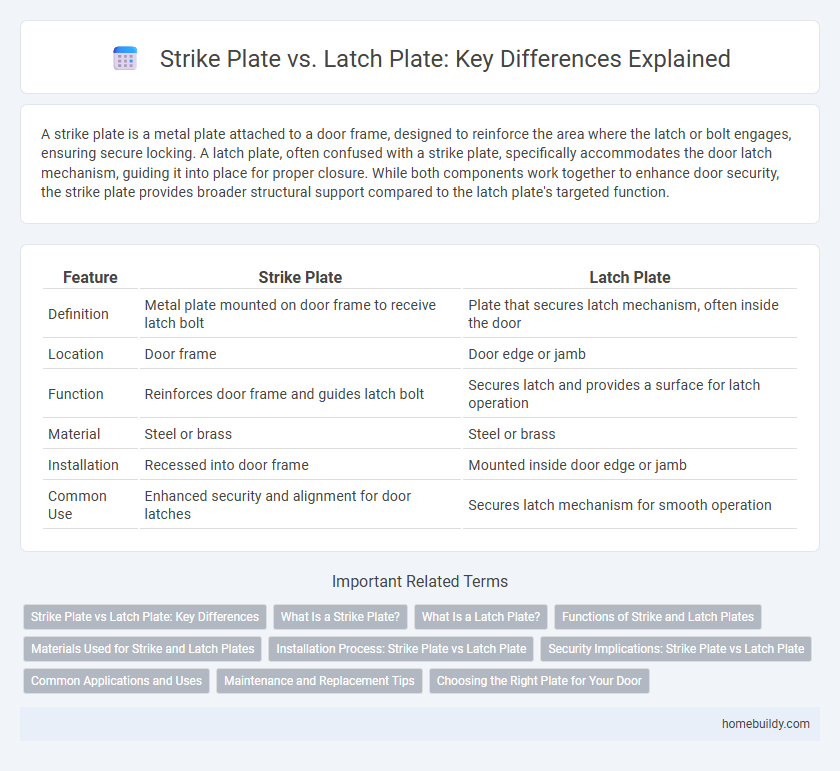A strike plate is a metal plate attached to a door frame, designed to reinforce the area where the latch or bolt engages, ensuring secure locking. A latch plate, often confused with a strike plate, specifically accommodates the door latch mechanism, guiding it into place for proper closure. While both components work together to enhance door security, the strike plate provides broader structural support compared to the latch plate's targeted function.
Table of Comparison
| Feature | Strike Plate | Latch Plate |
|---|---|---|
| Definition | Metal plate mounted on door frame to receive latch bolt | Plate that secures latch mechanism, often inside the door |
| Location | Door frame | Door edge or jamb |
| Function | Reinforces door frame and guides latch bolt | Secures latch and provides a surface for latch operation |
| Material | Steel or brass | Steel or brass |
| Installation | Recessed into door frame | Mounted inside door edge or jamb |
| Common Use | Enhanced security and alignment for door latches | Secures latch mechanism for smooth operation |
Strike Plate vs Latch Plate: Key Differences
Strike plates and latch plates are essential hardware components in door security systems, yet they serve distinct functions. A strike plate is mounted on the door frame and reinforces the area where the latch or bolt extends into the frame, enhancing door strength and security. In contrast, a latch plate typically refers to the metal piece attached to the door edge that interacts directly with the door latch mechanism, ensuring proper alignment and lock operation.
What Is a Strike Plate?
A strike plate is a metal plate attached to a door frame designed to receive the latch or bolt of a door lock, ensuring secure closure and alignment. Unlike a latch plate, which may refer to parts that interact specifically with the latch mechanism itself, the strike plate primarily serves as the point of contact where the door's locking components engage with the frame. Proper installation of a strike plate enhances door security by reinforcing the frame against forced entry.
What Is a Latch Plate?
A latch plate is a metal component installed on a door frame designed to engage and secure the door latch bolt when the door is closed. Unlike a strike plate, which accommodates both the latch bolt and deadbolt, a latch plate specifically aligns with the latch mechanism to ensure proper door closure and security. Proper installation of a latch plate prevents door misalignment and enhances lock functionality by maintaining correct engagement between the latch bolt and the door frame.
Functions of Strike and Latch Plates
Strike plates serve as the reinforced metal pieces mounted on door frames to receive and secure the latch bolt, ensuring the door stays closed and locked effectively. Latch plates, often integrated with the latch mechanism, guide and align the latch bolt during door closure for smooth operation. Both components work together to enhance door security and operational reliability by stabilizing the latch engagement.
Materials Used for Strike and Latch Plates
Strike plates are commonly made from durable metals such as stainless steel, brass, or zinc alloy, chosen for their strength and resistance to wear and corrosion. Latch plates often share similar materials but may vary in thickness and finish to accommodate specific door latch mechanisms and enhance aesthetic compatibility. Both components rely on high-quality metals to ensure long-lasting security and functionality in door hardware systems.
Installation Process: Strike Plate vs Latch Plate
The installation process of a strike plate involves aligning it with the door frame to securely catch the latch bolt when the door closes, often requiring mortising the frame for a flush fit. In contrast, a latch plate installation is simpler, typically mounted on the door edge or frame without extensive chiseling, primarily serving as a protective surface for the latch mechanism. Proper positioning and securing of both plates are critical for optimal door security and smooth latching functionality.
Security Implications: Strike Plate vs Latch Plate
Strike plates provide a reinforced metal surface that secures the door latch or bolt firmly within the door frame, significantly enhancing resistance to forced entry and increasing overall door security. In contrast, latch plates primarily serve as guides for the latch mechanism and offer minimal structural reinforcement, making them less effective in preventing break-ins. Choosing a heavy-duty strike plate with long screws anchored into the wall studs dramatically improves the door's defense against kick-ins compared to relying solely on a latch plate.
Common Applications and Uses
Strike plates are primarily used in door frames to reinforce the area where the latch or bolt engages, ensuring secure locking and enhanced durability. Latch plates, often integrated with the strike plate or used separately, specifically guide and support the latch bolt, commonly found in residential and commercial door hardware. Both components are essential in security setups, with strike plates prevalent in entry doors, and latch plates frequently used in interior doors for smooth latch operation.
Maintenance and Replacement Tips
Strike plates, typically made of metal, require regular inspection for signs of wear, rust, or misalignment to ensure door security and smooth operation. Latch plates, often part of the door latch mechanism, demand cleaning and lubrication to prevent sticking or jamming during use. For replacement, choose heavy-duty, corrosion-resistant materials and ensure precise alignment with the latch bolt to maintain optimal door function and safety.
Choosing the Right Plate for Your Door
Choosing the right plate for your door depends on the specific function and compatibility with your lock system, where a strike plate is designed to reinforce the door frame by receiving the latch or bolt, ensuring security and alignment. In contrast, a latch plate specifically secures the latch mechanism, often used with cabinet doors or lighter-weight applications. Proper selection between a strike plate and latch plate improves door durability, prevents misalignment, and enhances overall security effectiveness.
Strike plate vs latch plate Infographic

 homebuildy.com
homebuildy.com